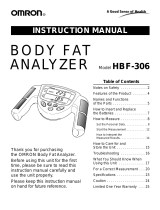
4
SAFETY INFORMATION
To assure the correct use of the product, basic safety measures should always be followed including the
warnings and cautions listed in this instruction manual.
OPERATING THE DEVICE
Do not use this monitor if you have a cardiac pacemaker or other implanted medical device. The Full Body
Sensor Body Composition Monitor and Scale passes an extremely weak electrical current of 50kHz and less
than 500µA through your body when taking a measurement to determine the amount of fat tissue. This weak
current is not felt while using the monitor. Do not use, or allow others to use, this monitor if fitted with a
cardiac pacemaker or other medical device.
Pregnant women should not use this device.
Contact your physician or healthcare provider before beginning a weight reduction or exercise program.
Keep the monitor out of the reach of young children. The cord can become entangled and cause strangulation.
Persons with disabilities or persons who are physically frail should be assisted by another person when using
this monitor or use a handrail, a walker, or other support device to prevent falling when stepping on and off the
monitor.
Read all of the information in the instruction manual and any other literature in the box before operating the
unit.
Do not use mobile telephones, microwave ovens or other devices that generate strong electrical or
electromagnetic fields near the monitor. This may result in an operational failure.
Do not step on the edge or the display area of the measurement platform. The monitor may tilt. The display unit
may be damaged.
Do not step on the measurement platform when your body or feet are wet, for example after taking a bath or
shower. You may slide and lose your balance.
Do not place the monitor on a cushioned floor surface such as a carpet or mat. A correct measurement may not
be possible.
Do not use the unit on slippery surfaces such as tile floors or wet floors. The monitor may move. You may lose
your balance and fall.
Do not jump on the measurement platform. You may lose your balance and fall. The monitor may be damaged.
Stand on the measurement platform with bare feet. Attempting to stand on the measurement platform when
wearing socks may cause you to slip and lose your balance.
Do not insert the batteries with their polarities incorrectly aligned.
SAFETY SYMBOLS USED IN THIS INSTRUCTION MANUAL
Warning
Indicates a potentially hazardous situation which, if not avoided, could result
in death or serious injury.
Caution
Indicates a potentially hazardous situation which, if not avoided, may result
in minor or moderate injury to the user or patient or damage to the equipment
or other property.





















